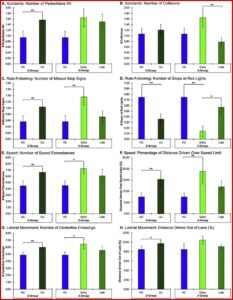
Driving under the influence of cannabis (DUIC) is a growing concern as states continue to pass legislation legalizing medical and recreational marijuana. There is evidence that acute cannabis intoxication is associated with impaired driving. Increased blood THC concentrations and driving within an hour of smoking marijuana were strongly associated with higher crash and culpability risks, according to “Cannabis Effects on Driving Skills.” There is also evidence that higher blood serum concentrations of THC-related metabolites are associated with greater impairment.
27.7 million people in the US report past month use of marijuana, 43.5 million Americans 12 or over report marijuana use in the past year. The number of past year marijuana users corresponds to about 15.9 percent of the population. The most recent US National Roadside Survey (data from 2013 to 2014) reported 12.6% of weekend, night-time drivers aged 16 and above tested positive for cannabis. This was a 48% increase from the last national survey in 2007. A 2015 CDC Morbidity and Mortality Report (MMWR) indicated 3.2% of individuals between 16 and 25 reported driving while high on marijuana.
Researchers led by Staci Gruber noted in “Recreational cannabis impairs driving performance” that previous studies of DUIC have focused on the effects of acute intoxication. Their study assessed the potential impact of marijuana use by comparing driving performance in a customized driving simulator of non-intoxicated, heavy recreational marijuana users with healthy controls (HC) who had no history of cannabis use. Consistent with prior research, they hypothesized that heavy, recreational cannabis users would exhibit impaired performance on a driving simulator relative to healthy controls, even in the absence of acute intoxication. In addition, impaired performance would be localized to onset cannabis users.
Cannabis users were defined as chronic, heavy recreational users when they used at least five of the last seven days, reported at least 1500 lifetime uses, and tested positive for cannabinoids. They were instructed to abstain from cannabis use for at least 12 hours before the study to ensure they were not intoxicated at the time of assessment. When they arrived at the laboratory, all participants provided a urine sample that tested for drugs of abuse (i.e., cocaine, opiates, marijuana, etc.). This procedure was done for three reasons: (1) to ensure all participants were drug free, apart from the presence of THC-metabolites in the cannabis-using group; (2) to confirm the presence of THC-metabolites in the cannabis-using group; (3) and to encourage cannabis users to comply with the 12-hour abstinence period.
In order to further explore the potential impact of age of onset of cannabis use on driving performance, the cannabis-using group was subdivided into two groups based on their age of onset of cannabis use, which was defined as the age of consistent, regular cannabis use (i.e., at least once per month). The early onset group included those with regular heavy cannabis use prior to or at age 16 (n = 14) while the late onset group included those with regular heavy cannabis use after age 16 (n = 14).
On the driving simulator, the cannabis users had significantly impaired performance compared to the healthy control group. Cannabis users hit more pedestrians, missed more stop signs, made fewer stops at red lights, exceeded the speed limit more often, drove a greater percentage of distance over the speed limit, and made more centerline crossings relative to HC participants. None of the participants had any off-road accidents or made any illegal turns. The HC and cannabis-using groups had similar numbers of collisions. See the following bar graphs.
 Data from the study suggests that chronic cannabis use is associated with impaired driving performance, even when chronic users are not intoxicated. When cannabis users were divided into early and late onset of cannabis use, the results showed that impairment was primarily located within the early onset group, cannabis use starting before the age of sixteen. These findings provide evidence that non-intoxicated early onset cannabis users have poorer driving performance. This suggests there may be a residual effect of chronic, heavy recreational cannabis use, especially when regular use begins during early adolescence. When self-reported impulsivity was controlled for, most of the significant differences between the HC and cannabis users were no longer significant, “suggesting that increased impulsivity within the cannabis users impacts, at least in part, the performance differences observed on the driving simulator.”
Data from the study suggests that chronic cannabis use is associated with impaired driving performance, even when chronic users are not intoxicated. When cannabis users were divided into early and late onset of cannabis use, the results showed that impairment was primarily located within the early onset group, cannabis use starting before the age of sixteen. These findings provide evidence that non-intoxicated early onset cannabis users have poorer driving performance. This suggests there may be a residual effect of chronic, heavy recreational cannabis use, especially when regular use begins during early adolescence. When self-reported impulsivity was controlled for, most of the significant differences between the HC and cannabis users were no longer significant, “suggesting that increased impulsivity within the cannabis users impacts, at least in part, the performance differences observed on the driving simulator.”
Importantly, this study extends previous findings showing that early cannabis onset is associated with a variety of cognitive declines including poorer attention, verbal memory, visuospatial skills, and executive functioning. Although these results occurred in a simulator, an increased number of collisions in non-intoxicated early-onset cannabis users was similar to reports from other acute intoxication studies that found an increased number of collisions. Epidemiological studies have also found an increased risk of motor vehicle collisions associated with DUIC.
Studies of acutely intoxicated individuals are associated with slower driving, increased number of collisions, increased lateral movement, and slower reaction time. In several studies, drivers demonstrated insight into their intoxication and reported adopting a slower driving style in order to compensate for impairment. The main difference between acute impairment/DUIC findings and the current study is driving speed. Acute intoxication was associated with slower driving, while chronic use without acute intoxication was associated with faster driving.
Taken together, the discrepancy between these findings suggests that acute cannabis intoxication results in a different type of driving impairment relative to residual impairment in the absence of acute cannabis intoxication, which appears to be associated with an impulsive style of driving.
The study indicated there was residual driving impairment in non-intoxicated cannabis users, that was specific to those with early onset cannabis use. Prior studies of acutely intoxicated and DUIC individuals saw a slower style of impaired driving behavior. However, the current study suggested that early onset users had an impulsive style of impaired driving, which may be related to characteristics inherent with individuals who begin cannabis use at earlier ages.
Given increased legalization of cannabis, growing numbers of cannabis consumers, and increased prevalence of drivers testing positive for cannabis metabolites, results from the current study underscore concerns about the impact of cannabis use on driving as a potential public safety issue.
Staci Gruber, who is the senior author of the research study described here, is one the world’s foremost experts in the cognitive effects of marijuana. She said in an article for ScienceDaily, the idea that differences can be detected in sober cannabis users may be surprising to the general public. Since performance issues can occur even in people who are not high, Gruber said the public needs to rethink the ways it understands impairment. Although there has been a lot of interest in more readily and accurately identifying acute cannabis intoxication, it is critical to assess impairment regardless of the source or cause and to distinguish between recreational cannabis users and medical users.
It’s important to be mindful that whether someone is acutely intoxicated, or a heavy recreational cannabis user who’s not intoxicated, there may be an impact on driving, but certainly not everyone demonstrates impairment simply as a function of exposure to cannabis. This is especially important to keep in mind given increasing numbers of medical cannabis patients who differ from recreational users with regard to product choice and goal of use.





